Gabriella Boyes | Shayna Herzfeld | Hayden Freedland | Campbell Lucas-Miller
Walking in Toulouse
In Toulouse, pedestrians are everywhere. Everyone walks to go to work, school, or even to go out in the evening. When I arrived in Toulouse, the step-tracking app on my iPhone informed me that the number of steps I was taking each day had gone up a lot! Before Toulouse, I was walking about 5,600 steps per day on average. Nowadays, it’s more like 13,000. In the U.S. if you want to exercise, you go for a walk. Oftentimes, my mom will go walking for exercise, as a type of “sport.” She walks around our neighborhood and then comes back home. In general, she doesn’t walk far to get places. Cars are the preferred mode of transport. As a result, to walk, you have to set aside time.
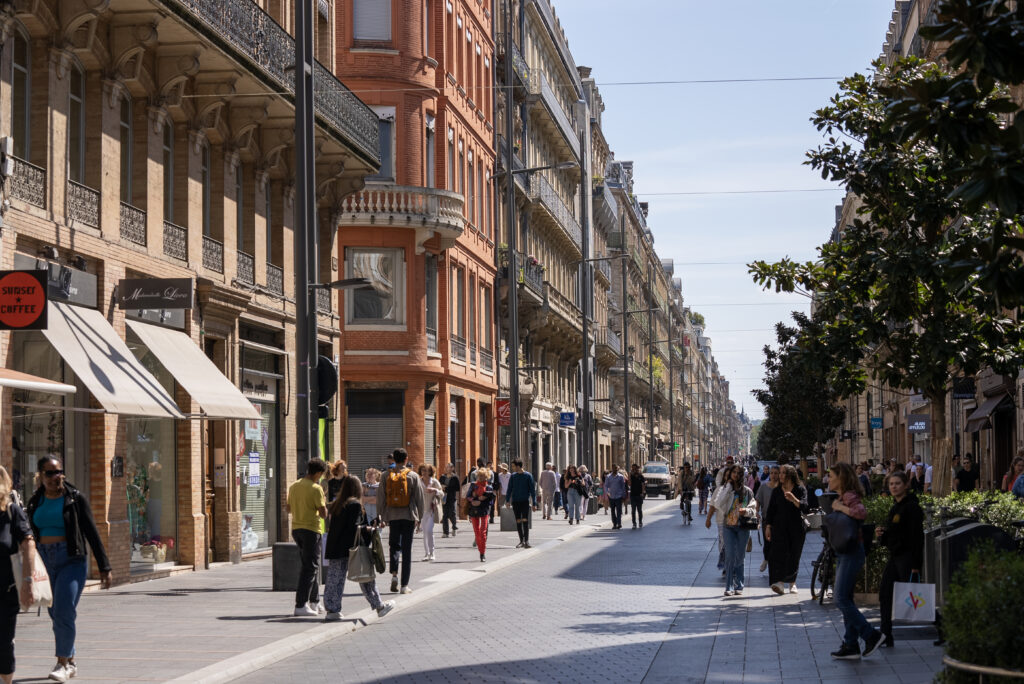
In the U.S., sports and exercise are separate from transport. However, in France, it’s common for them to be one and the same.
Here, in general, walking is not a sport, but walking is athletic. When I leave for the metro, a lot of people are walking quickly to get to their destinations on time. On the left side of the escalators, people climb the steps rapidly. If people want to stand, they always stand to the right and let escalator-walkers go through on the left. If the escalators are full, there are a lot of stairs you can take instead. When I first arrived, after I climbed the stairs at the metro I was a little tired, but not so much anymore. During the organized tours with Dickinson, our French tour guide would often ask us “Am I walking too fast?” because most of the American students were lagging behind.
In the U.S., sports and exercise are separate from transport. However, in France, it’s common for them to be one and the same. My hostess, Blandine, walks to work and her husband, Nicolas walks to mass every morning. The roads in Toulouse are designed for pedestrians, with big cobblestone roads and barriers to keep out cars. As a general rule, the city is very walkable.
It’s interesting to see that in one country an activity can be perceived as a sport, but in another country, it’s just a way of life.
When I asked a French friend if French people consider walking exercise, she said, “In the city, no, because everything is close but also kinda far.” This comment is indicative of the sentiments of Toulousains, which is that walking is an inextricable part of their life. As a general rule, people in Toulouse don’t pay attention to their step count. Fitness trackers like Fitbits are not as common here. In the U.S. I have a lot of friends who are competitive with their step count for the day because in America you have to be more intentional about “getting in your steps.” It’s a way of showing you’re athletic. Here, it’s not a big deal. It’s interesting to see that in one country an activity can be perceived as a sport, but in another country, it’s just a way of life.
Pétanque and Cornhole
Walking the streets of Toulouse, you will see at least one person in the parks throwing a ball. The first time that I saw this game, I was a bit surprise to see people playing what I thought was cornhole in a public space so frequently with people that they did not know. But a friend explained to me that this game was not cornhole, it was a French game called pétanque! So, when it came time to pick a sport for the subject of this article, I knew that I had to pick pétanque.
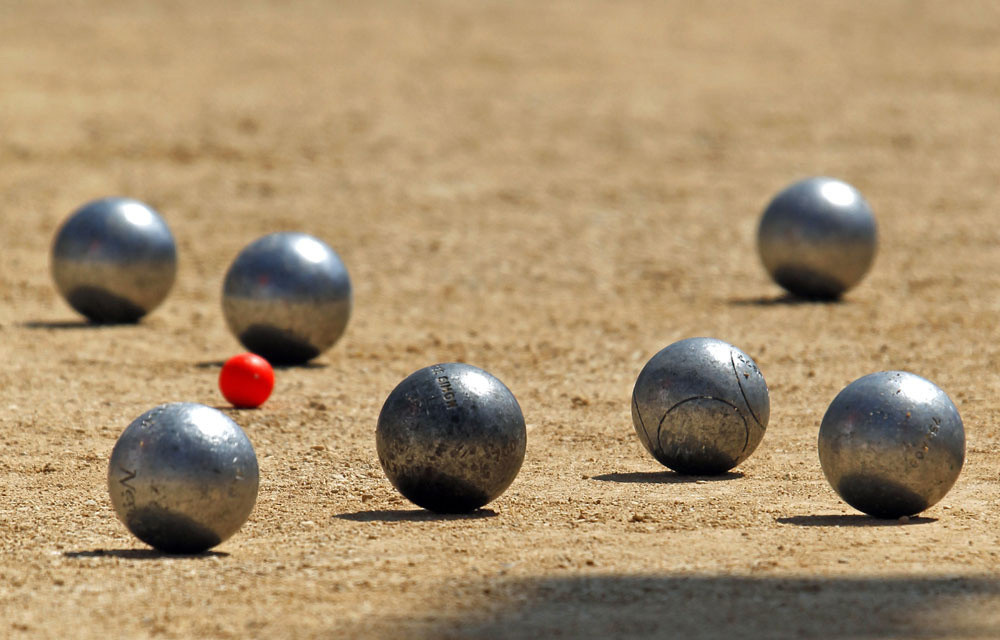
To begin, we need to understand the rules, starting with the terms used in each game. The balls that you throw in pétanque are called boules (each player has one or two boules depending on how many people are playing). But there is another ball which determines who wins, called the cochonnet. The goal of the game is to throw the ball as close as possible to the cochonnet. If a team has the boule closest to the cochonnet, they win one point. If they have the two closest, they win two points. The game is played until one team wins 13 points – then they’re the winners!

Now, to discuss the rules of cornhole – the game uses two boards (each has a hole) and four sacks for each team. The players throw the sack and the goal is to get the sack in the hole. If the sack goes in, the team wins three points. If the sack lands on the board, the team gets three points. The team with the most points at the end of the round (when all the sacks have been thrown) wins the difference in points between the two teams. The first team to get 21 points wins the game. To be honest, before researching this I did not know that there were so many specific rules and terms in cornhole.
[I’ve noticed differences regarding] the place in which people typically play the game. [When] I hear people talking about playing pétanque, they usually seem to want to play in public spaces.
Now that we know the rules for each game, we can look at the similarities and differences between the two games. For one difference, we can look at the place in which people typically play the game. In France, when I have seen people play pétanque, it is generally in public spaces. It is true that I have not seen many private spaces in France, but when I hear people talking about playing pétanque, they usually seem to want to play in public spaces. For cornhole, it is the opposite – this is a game that is generally played, in my experience, in the backyard or garden of a house with friends or family. Another difference is the people with whom you usually play. As I mentioned before, cornhole is usually played in private with people that you already know. But for pétanque even if people do play with others that they already know, I have also seen people meet in the park and just start playing together! Moreover, I know that in France there are public meetings for people to come together and play.
One […] similarity, which might be the most important, is the atmosphere and intention of the game. In both countries, these two are games for relaxing and spending time with others.
Next, we can look at some of the similarities between the culture of the games. There is an obvious similarity between the two games, that people throw an object at a target to try and win points. But the two games also both have international competitions (which surprised me!) even though most people think of the games as an informal pastime. One last similarity, which might be the most important, is the atmosphere and intention of the game. In both countries, these two are games for relaxing and spending time with others. Whether you are looking to meet new people or play with those you already know, these are games for people of all ages and levels to enjoy.
Soccer
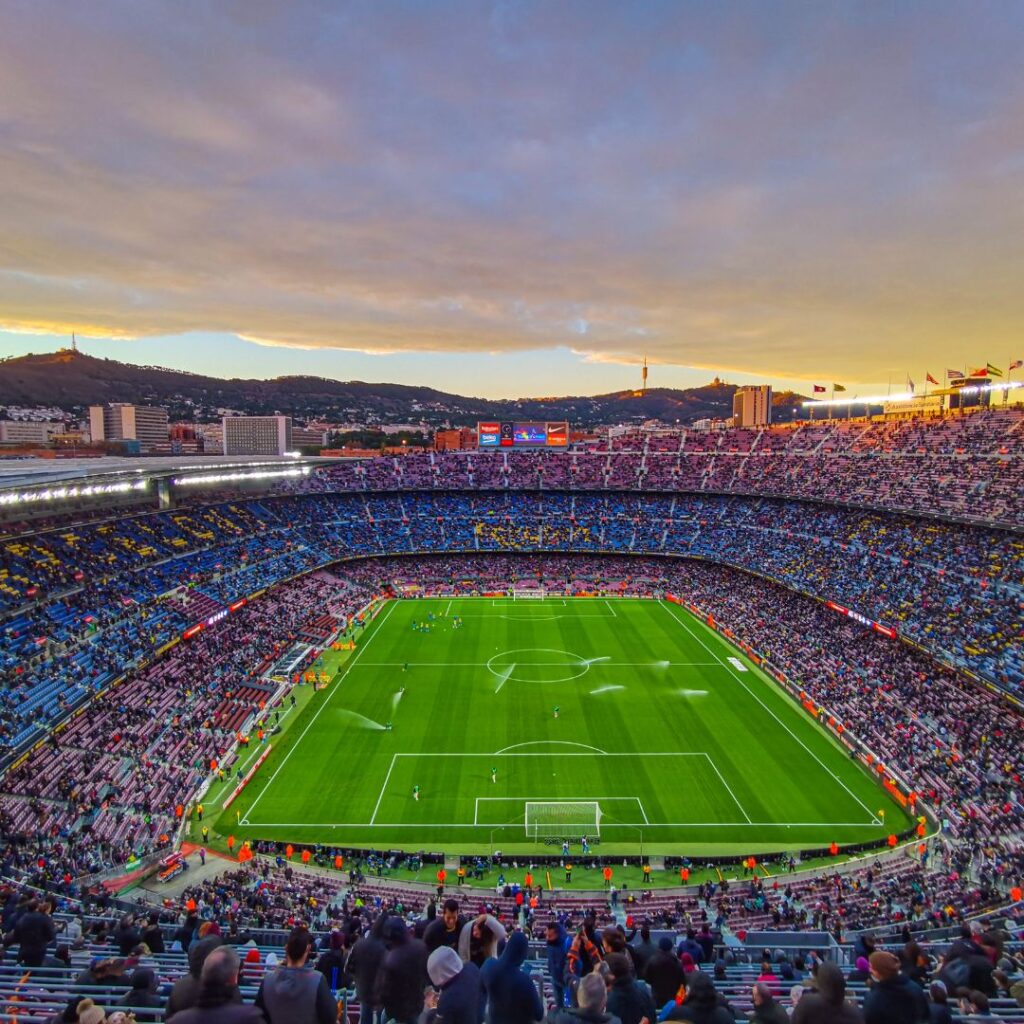
The most watched sport in the world, football, as well as many of its athletes, are easily recognizable, so much so that top players like Messi, Ronaldo, and Mbappe can be identified by just their last name. Despite the sport’s popularity, football, or known to Americans as “soccer”, remains the fourth or fifth most popular sport in the United States. The reason behind this is not due to the men’s national team being bad, in fact the men’s national team ranks as the eleventh best team in the world according to FIFA. While there are only a few teams separating the United States and France, the biggest difference regarding sports in the two countries is the culture that surrounds it. Even in Toulouse, a city that prefers rugby, I have seen football played in the streets, I have witnessed the metro filled with Toulouse Football Club supporters, people wearing jerseys from all over Europe, and advertisements with footballers. It is evident that the culture and passion for football in France is strong and is representative of the rest of the world.
[The] biggest difference regarding [soccer] in the two countries is the culture that surrounds it.
When I asked my host why exactly she thought that soccer culture in France was different compared to the United States, she was honest and said that she didn’t understand why. She said given the popularity of the women’s team and the recent success of the men’s team, one would think that the sport would have a strong culture and support that matched its success. I followed this question up by asking her why, even in a region that prefers rugby, would football be the obvious second favorite sport. She said both sports bring people together; rugby brings together people within the region and football brings people together all over the country. This interested me because I had never considered the importance of the national team in this context and I think it is the reason why there is such a disparity between the two football cultures.
Both sports bring people together; rugby brings together people within the region and football brings people together all over the country.
As my host explained, even in the south of France where rugby is more popular, people get together for both the local rugby teams and the national football team. Compared to the United States where several sports bring people together, there is a greater sense of local pride created because in most major cities there are four professional teams. Even sports with international competition that are more popular in the United States like baseball and hockey, there is still a greater interest in local and national competition than in international competition. This relative lack of interest in international competitions in general may explain why a sport that relies on international competitions, soccer, does not have the same culture and passion in America. From a French perspective, I would be surprised if a nation that notoriously has a sense of national pride didn’t have a strong support for their national football team. After making this comparison, it has left me a little disappointed as a soccer fan since there is the potential for a strong soccer culture to exist in the United States, but as of right now, it simply does not come close to the culture in France.
Rugby in Toulouse
During my first few weeks in the city of Toulouse, I noticed an unfamiliar logo on local buildings, homes, cars, and on clothing around the city. I knew that it was a sports team due to the numerous jerseys I saw people of all ages wearing, but I assumed it must be a soccer (football) uniform. Previously, I was aware that sports like American football, basketball, and baseball weren’t very popular in Europe. According to what I had been told, soccer was the undisputed dominant sport of the continent. I was astonished after speaking to some classmates to find that the black “T” and red “S” stands for Stade Toulousian, nothing less than the local rugby team. To learn more about the culture of Toulouse and this game of rugby, I spent the next couple of days pestering the people around me for rules, watching the group stages of the very conveniently-timed Rugby World Cup, and even joining my university’s rugby club.
In France, rugby is easily one of the most popular games. In the south particularly, the sport dominates and reaches even higher levels of fanaticism than soccer.
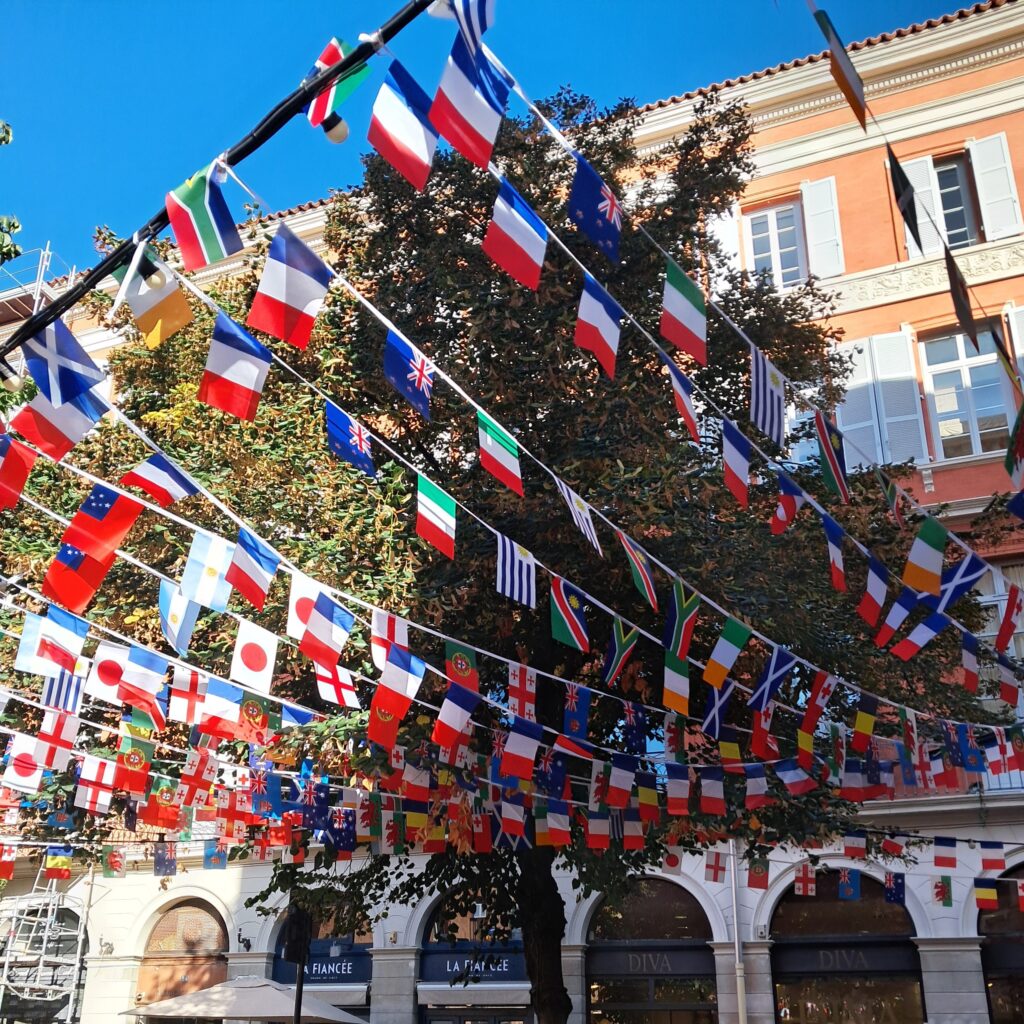
As I learned more and more about the sport, I began to research the teams both in France and the United States. In France, rugby is easily one of the most popular games. In the south particularly, the sport dominates and reaches even higher levels of fanaticism than soccer. The French national team regularly ranks near the best in international play, being ranked fourth in the world coming into the 2023 Rugby World Cup. Arguably the best player in the world, Antoine Dupont, leads the French side. While a World Cup championship win has evaded the Les Bleus team, they have played in the finals three times. Domestically, rugby remains highly competitive. The most developed and historied league in the world, Top 14, calls France its home. The league began in 1892, making it the oldest rugby league. Many of the top players from France, as well as other historical Rugby countries (such as England, South Africa, and Australia) play on domestic French teams. Evening matches can regularly pull 800,000 views. However, French rugby remains highly regional, with 12 of the 14 teams being based in southern cities. Small southern cities such as Castres (with a population of about 40,000) are better represented than large northern cities such as Lille (with a population of about 230,000). Many of the players I have met while playing in Toulouse came from Toulouse or small towns or cities in the south of the country, such as Perpignan, Bordeaux, or Marseille.
In the late 1800s, rugby was played at American colleges until being eclipsed by American football near the turn of the century. American football occupies a similar cultural niche in the Unites States as rugby has in France and Europe.
Conversely, rugby in the United States remains relatively unpopular as the American public prefers other sports such as American football, basketball, and even soccer. In the late 1800s, rugby was played at American colleges until being eclipsed by American football near the turn of the century. American football occupies a similar cultural niche in the Unites States as rugby has in France and Europe. Despite that, rugby has recently become one of the highest growing sports in the Unites States. Rugby has resurged at the college level and has not yet achieved mass interest. Due to the renewed interest, a new domestic league, the Major Rugby League was established in 2016. Internationally, the Unites States Eagles achieved early success in the sport, winning a few gold medals at the early Olympic Games. Since then, the Eagles have had less success. The United States has qualified for every rugby world cup except two. Despite this consistency, the Eagles have only managed to win one game, never making it out of the group stage. Due to renewed interest in the sport by the American public, a new domestic league, the Major Rugby League was established in 2016.
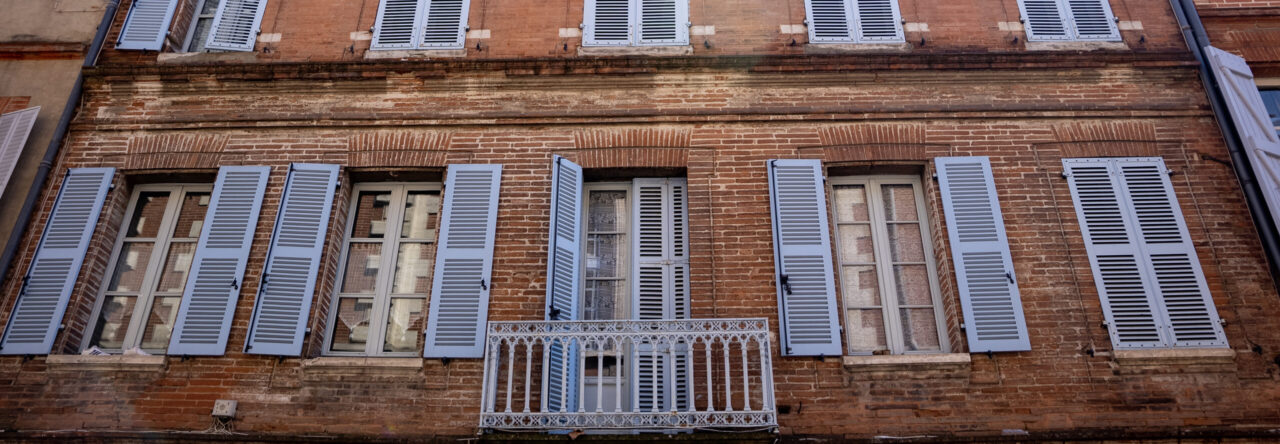
Leave a Reply